May 15 - 21 2016: Issue 263
Cottage Point Rural Fire Brigade
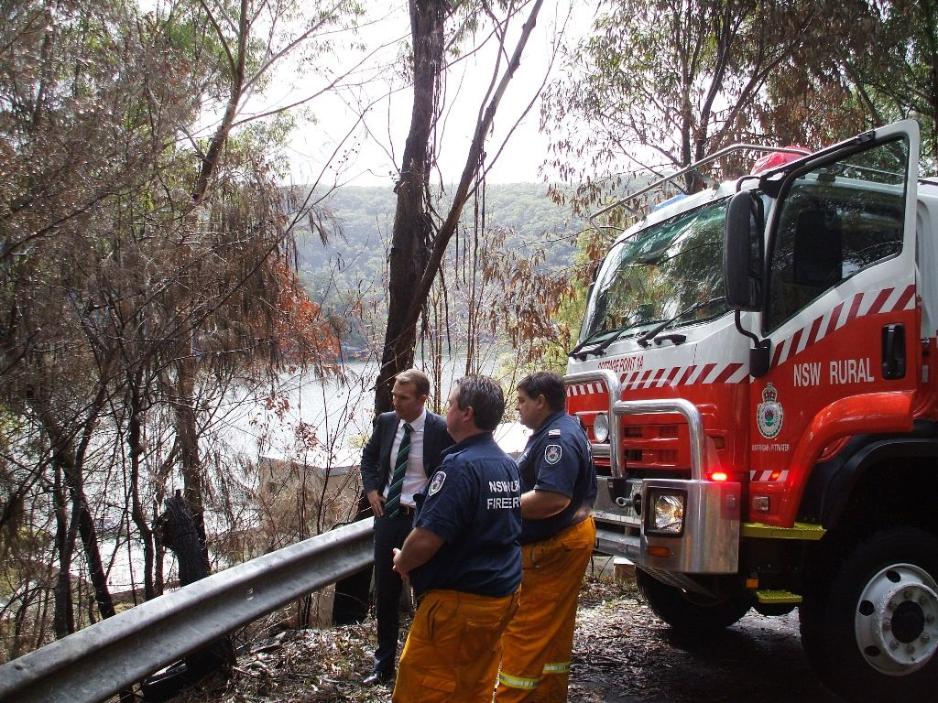
How many members do you have?
We have 18 Active Members and four Life Members – Mr. Phil Lynch (dec.), Mr. Graeme McCall (dec.), Mr. Ken M’Naught and Mr. Murray Campbell.
When was Cottage Point Rural Fire Brigade first started?
The inaugural meeting of this Brigade was on January the 5th, 1957.
The original letter reads, addressed to the Shire Clerk at Warringah Shire Council:
‘Dear Sir, we have to inform you that on January 5, 1957. a Volunteer Freighting Brigade was formed at Cottage Point, to be known as ‘Cottage Point Volunteer Bush Fire-fighting Brigade’.
The following Officers were elected
Mr. Sydney Allbright, President, Mr. J Crouch, Vice-President, Mr. D Anderson, Captain, Mr. P Windybanks Deputy Captain, Mr. W Board Deputy Captain, Mr. D Anderson Temporary Equipment Officer, Mrs. M Anderson Secretary and Treasurer.’
These were all locals who gave much and did much for our community.
The interesting thing is that the Post Office Box number for council at this time was GPO Box 3956, Sydney. For those listed, Mr. Allbright has a Sydney address, Mr. Crouch is Bourke Street in East Sydney, while Mr. Anderson is ‘Cottage Point via Brooklyn’; so the mail for everyone in those days came via the riverboat postman from Brooklyn.
How long have you been part of the Rural Fire Brigade Jon?
I first joined the “Bush Fire Brigade” on the 8th of November, 1979. I’ve been a member of the Cottage Point Rural Bush Fire Brigade since 1992 and have been Captain for almost 15 years collectively.
Of your current 18 members, how many are men and how many women?
Fifteen men and three ladies make up our general membership. We have Rebecca Tattersall as our first female brigade President and aged 22yo, we have Chrys Maoudis as our Vice President and aged 21yo whilst Marcus Collignon is our Secretary at age 22yo.
After attending University, Rebecca has recently qualified as a Solicitor, Chrys has a earned a degree in Medical Science whilst Marcus is studying Paramedics so we’re fortunate to have some very bright young members.
Rebecca’s Mum Karen, who is a General Practitioner, is also a member of the Brigade, as is her father Matt.
Anthony is our Callout Officer – he’s the one who makes the calls at all hours when a crew is needed urgently. Our two Equipment Officers are Michael and Anthony, they get on brilliantly and everything is ready to go all the time. Their job is not to repair major equipment, more so to see that general maintenance of things such as chain saws is carried out. They also check the vehicles and make sure everything is up to speed and if it’s not, they do the paperwork to ensure that it’s fixed. Our vehicles are all taken care of by our RFS District Mechanic Darryl and he does a brilliant job. Whilst located in an isolated location, we enjoy having one of the best equipped station the RFS has and our issued equipment such as our Tanker and Hilux 4X4 are both modern and contain the latest support equipment.
So that’s a few generations who are active members?
We do have some of that, yes. I remember I joined for one reason, not for medals or kudos or Life Membership due to length of Service – but because I wanted to help, I wanted to do something for my local community; I was born and raised in Narrabeen, went to North Narrabeen Public School, went on to Narrabeen High; people here want to do a bit to help their local community.
In Christmas 2001 we were called to go up to the Blue Mountains. It was bad, they had big problems up there. We took a full crew of six on the Tanker out of Cottage Point and raced up the Mountains to help. On that crew, one of our members was the Honourable John Brogden, former Member for Pittwater and I will vouch forever and a day, John worked his guts out alongside the rest of us. He even ate Devon and Sauce Sandwiches (courtesy of the Salvo’s) like the rest of us and drank GI Cordial!
He actually knows what it’s like when you see a bushfire coming at you.
On that day there was a young couple on Albert Road at Bullaburra and between Belrose Brigade and ourselves. I don’t know how we saved the place, but we did. When we were finished I had everyone on the grass out the front, they were absolutely physically exhausted, including Broggers, and this young couple could not let go of us. They were in tears thanking us because we’d just saved their house. If people can imagine losing everything you have they may understand the level of appreciation we can experience during these episodes. If you don’t do another bloody thing all year, then you’ve just done a pretty good job anyway I reckon.
You would never forget that?
I haven’t. When you know you have put a smile on someone’s face, that you have saved things like all their photos of their grandparents, their mum and dad, their children. For those that have lost everything, it’s terrible, devastating.
To save someone’s house or life is a pretty good feeling. You can stand someone on a pedestal and say ‘you’re wonderful’ and ‘here, have this medal’ BUT that’s not what it’s about – I say ‘big deal’ to that – it’s about what really matters, the people, the little things that you can’t replace.
Have you seen a bushfire coming at you at Cottage Point Jon?
I’ve seen a few.
What’s the worst one you have seen at Cottage Point?
1994, without a doubt. It was the 7th of January, a Friday at 4.30, 5pm in the afternoon – I’ve never forgotten that and never will. We were here at the station all day and could see it was getting worse by the minute – we had a fire to the north at Gosford, we had a fire to the west of us blow up in the Muogamarra and Marramarra National Park, it looked like a nuclear mushroom was developing around us.
At 4.30/5.00 we were up on Christmas Tree Hill on Cottage Point, which is the halfway mark along Liberator General San Martin Drive. From the top point there you get a good vantage to the north.
Our Group Captain on this day was Keith Bennet, who used to be a Council Ranger for Pittwater, a top bloke. He called us and asked us to look north and tell them how far the fire was spotting. I looked at Murray Campbell, as he was Captain through the 1994 fires, and said, ‘mate, that’s blowing ten kilometres ahead of itself.’
We weren’t far off because it was only a matter of minutes later that it broke out at Cottage Point.
Keith told us to make ourselves safe, that this was an extreme fire and it was going to be bad.
How did you respond to this fire?
Vicki Campbell, Murray’s wife, was standing on the truck tanker and she was the first to spot the smoke. It broke out at the end of Cowan Drive. There’s a little area down there called ‘Little Botany Bay’.
Murray called it in and they sent response units out here. We raced down the hill in the tanker, back along Cowan Drive to the extreme end; I was driving, Murray was in the left seat – we took one look at it and knew - ‘forget it, it’s gone’.
The wind was 45 kilometres an hour when the fire started, and it was at 65 kilometres an hour later. People forget that fires like these create wind.
That shot up the hill out of Little Botany Bay and went straight across Cottage Point road. As soon as it raced up the hill we turned the truck around and got back out of Cowan Drive and up Cottage Point Road to where the station is today, because it’s all been rebuilt and reopened in 1998.
We were trapped out here for 24 hours; the road from Terrey Hills for us had fallen trees everywhere; the SCS worked their guts out cutting trees in order to restore a passage through to Cottage Point.
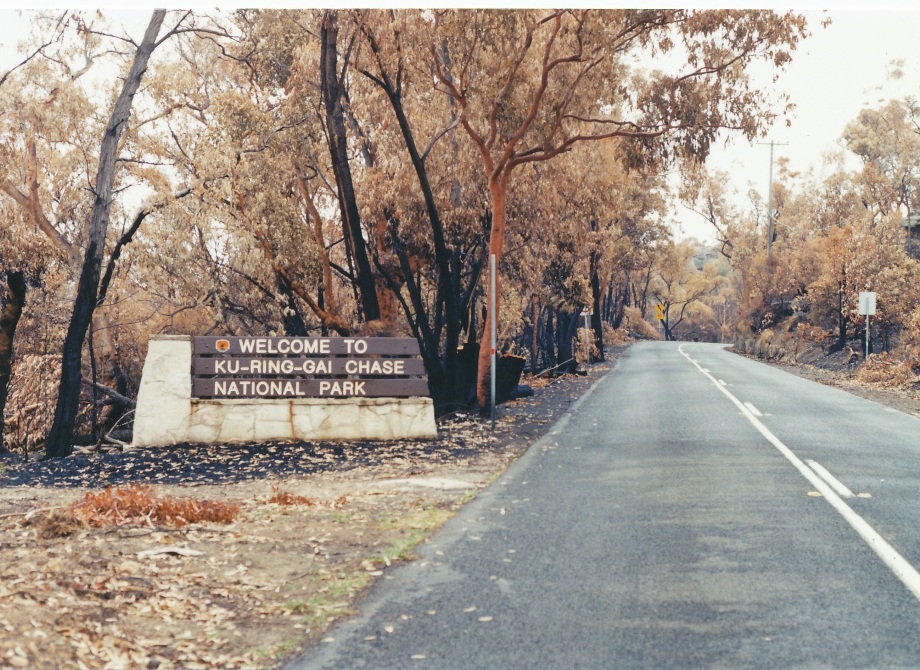
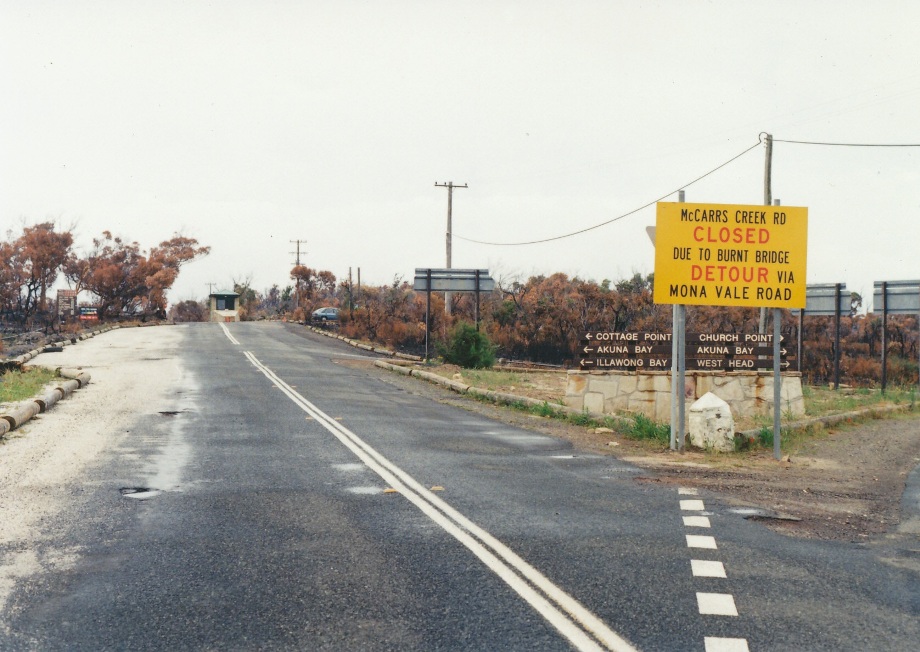
That fire that day was horrendous – everyone could hear me on the radio at one stage calling for water – we don’t have town water at Cottage Point. All we had was a 5000 gallon tank behind the old station. The truck itself held around two and half thousand litres.
We managed to save every house here; the crew worked themselves into the ground. One guy ended up going to hospital suffering from severe heat exhaustion and didn’t come back until well after all the fires were over.
When it was all over we were sitting outside of the station saying ‘that was a hell of a fire’ when someone said ‘Oi’!’ – we looked through and at the back of the station we could see flames through the window – so we saved the community and lost the station!
Something was there, a stray ember – and that’s what happens, a bit left, a bit of wind on it and it comes to life again.
It was Friday afternoon when it started and we didn’t get out of here until Sunday afternoon.
When we did we went to the control centre at Terrey Hills. Keith Bennet was up there and asked Murray and I to come up while the crew cleaned the truck and refilled it with water and fuel, got everything ready to go again, as this fire was still going everywhere, and Keith looked stuffed, he was exhausted. He said, ‘alright, give it to me; how many houses have we lost?’
Murray answered, ‘we haven’t lost any.’
That fire, once it shot through the Park (Kuring-gai Chase) it branches out – and that’s what it did with that wind behind it, it went in all directions; Elvina Bay, Lovett Bay. Bayview, Church Point, Ingleside, Terrey Hills, it went through everywhere. The worst scenario for us would have been if it had gotten through to what we call the 'Great Eastern Firebreak' – and that’s the ocean!
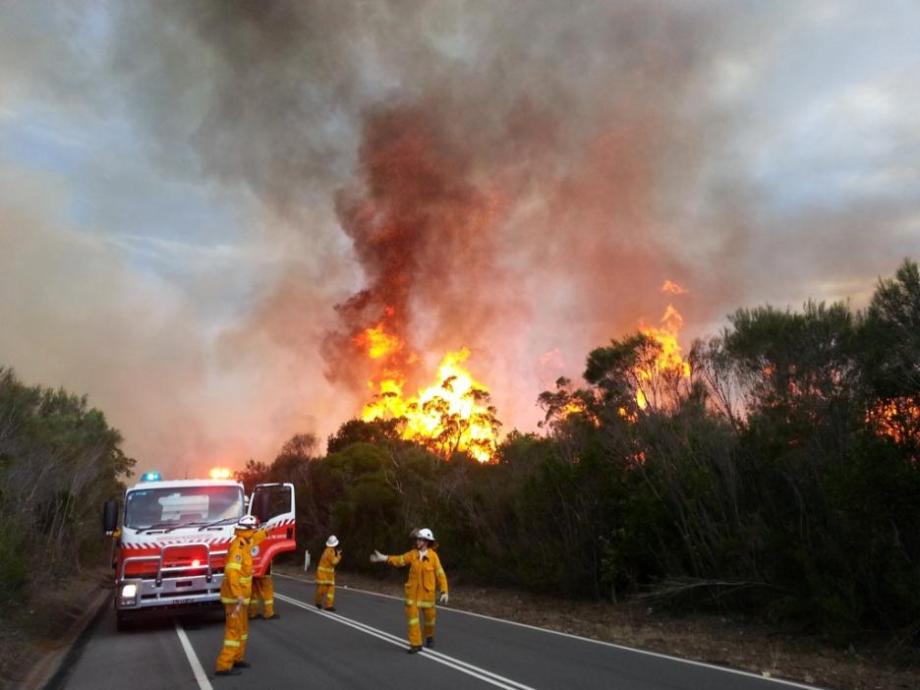
How did you replace the station?
The members built the new station, which took us four years, I wrote so many letters asking companies to give us building products or funds towards what was needed; I can remember writing letters for two years until 3 in the morning to get product – John Brogden said on the opening day ‘people gave you what was needed simply to get you off the phone!’ – but it worked, we got it done and got it built.
I must mention former Warringah Mayor Julie Sutton here, she’s as straight as they come and she got us the most amount of money ever got out of a council for a rural fire station – she’s an absolute champion and it’s a pity she’s still not serving as a councillor.
At that time she got $189 thousand for us and did her utmost to ensure the council tradesmen, which they don’t have anymore, helped us as much as possible too - they helped install the villaboard ceiling.
If someone wants to become a member of a Rural Fire Brigade, what do they do?
You contact the brigade you want to join initially and let them know you’d like to be a part of this.
Prospective members then do a Friday night at the Control Centre for around two hours; this is an Introduction where people get to know each other and are informed about what will happen over the first few days of their training. They’re allocated a uniform – boots, pants, helmet and jacket.
The process of the training is also explained – the bulk of this is done at a local brigade level – you get in contact with the brigade you want to contribute to and be a part of. The initial training is done at the District Office so they have a record of this. They then do all day on the Saturday and Sunday, from 9am to 4pm, for their Basic Training.
You then spend around the next three weeks back at the brigade you’ve chosen to join, such as Cottage Point, and we help you, the new member, to understand how everything works; the equipment, such as how to start the pumps or turn the taps on and attach the branch (hose), how the station is run, how to put a ladder up safely and securely and climb up, how to use fire extinguishers, how to use hand tools if you have to cut a fire trail. The safety standards in this District are very high and prospective members are equipped with everything they will need but it’s not rocket science – it’s procedures and being trained.
They then go back to the Control Centre for a full day’s assessment.
What to you is the best part of being at Cottage Point?
Even though I have only 18 people here, you couldn’t ask for 18 better people – they give their heart and soul.
How does Cottage Point prepare for a bushfire season?
Cottage Point is a little different from other areas as we don’t have actual fire trails; we have a number of National Park blocks of land mingled among the residents here. Some of these may be marked for Hazard Reductions, if the conditions allow this to occur.
What do you do during the off season?
We do pancakes beautifully. We love our pancakes and have a number of members who have become proficient at pancakes and received a Degree in Pancakes. Rebecca organised Australia Day pancakes, told us what she wanted, how she wanted it done. Melissa was in charge of hotplate, some of the other members may help but she’s always ready to step in and help them out…
But of course we’re doing training exercises during the cooler months, and these are also part of our exercises every weekend throughout the year unless we’ve been deployed.
We also do other exercises such as this month with we have a familiarisation of all waterfront Brigades. West Pittwater Brigade will assist us, as they have a boat and we don’t. Marine Rescue at Cottage Point help us quite a lot too, and we’ll go around to Mackeral Beach and have a look at their equipment and vehicles so my members know what they have. We then go to Scotland Island, then West Pittwater, Lovett Bay station so our members understand the waterfront brigades as well.
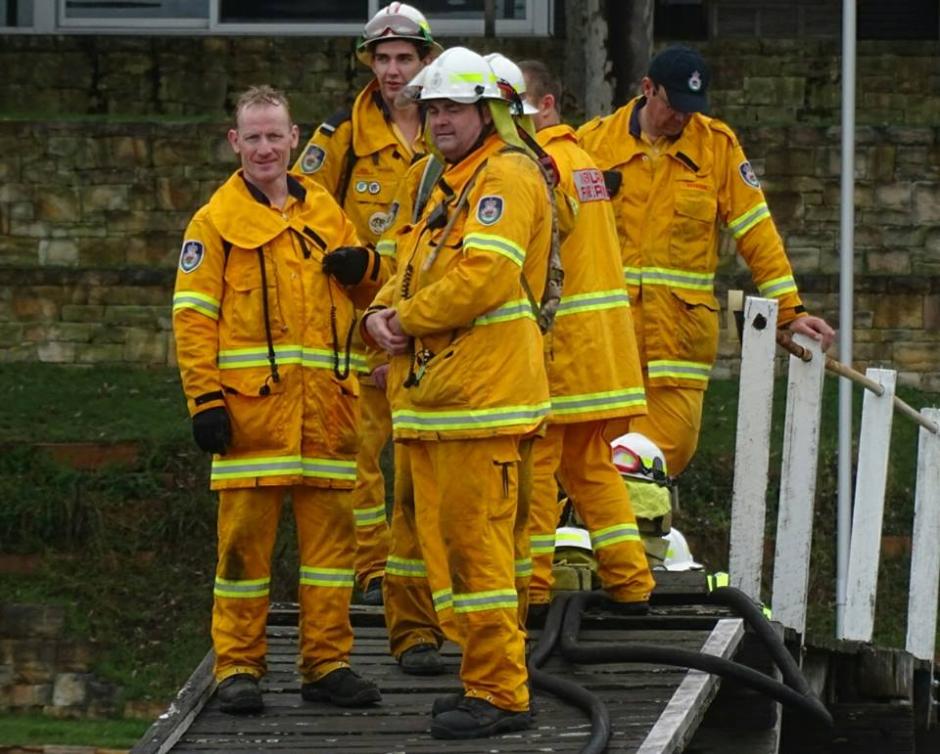
Why doesn’t Cottage Point have a boat?
We haven’t been allocated one as yet.
Marine Rescue Cottage Point have been brilliant to us over the years. They, through the generosity of the Kuring-Gai Yacht Club, have access to a room on their premises which is used as their Radio Room. When Marine Rescue Cottage Point have training sessions they have use of our station as they may need larger facilities.
When we have a problem out here and the road may be cut off and access not available, our station is fully self-sufficient. We have a big diesel generator that can power the whole building. We also have marine radios here at Cottage Point station so, if their power fails below us, they can come straight up here and use the same radios they have down there. We work together, we support each other. By our two services working together we deliver a great service for the public and what we’re here to do – maintain safety and protect lives. It’s really about utilising the equipment we have and putting it to the best use – common sense really.
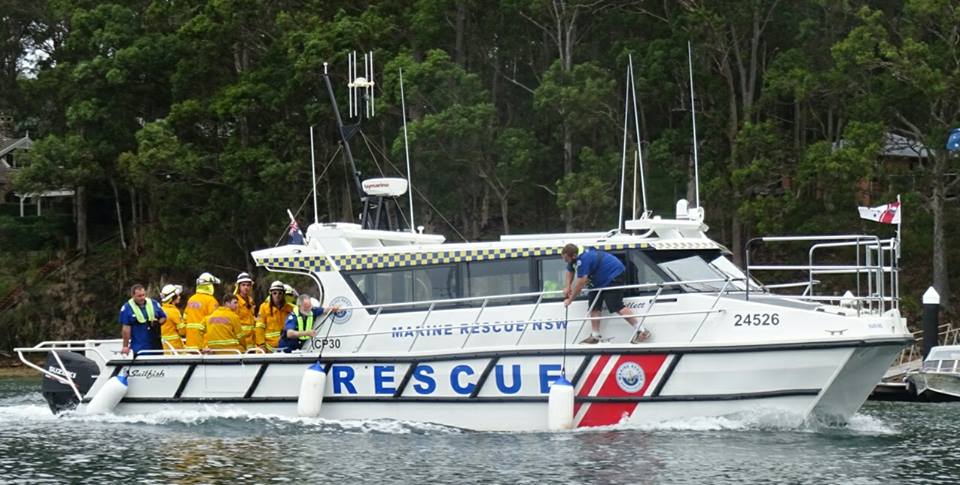
Wouldn’t Cottage Point’s landscape make it a funnel for any fires that come through?
In some ways – if it’s not Duffy’s Forest then Cottage Point is quite often the entry point for fires because if you have a fire to the north, as we did in 1994, with northerly winds, the smoke and embers it will get funnelled into here. If you have a fire to the west and have a westerly blowing this is where it will come to once again. In 1994 we had a nor’ wester blowing didn’t we – so we were at the landing point for both fire directions.
We got the best of both worlds that weekend!
It’s all about wind – it may be 60 degrees and not a puff of wind and if this does occur, you can stomp on it. Wind is the problem, and the wind these fires can generate once they get going; this is the single biggest factor every time – which direction and how fast.
So you’re right – that is a key focus – there is an entry point for any fire in the Pittwater- Warringah area that’s why this station is always manned on a Total Fire Ban day. Fortunately I work in State Transit for the government, in buses, and they have been incredibly supportive of my RFB duties over many years and have enabled me to man the station during these Total Fire Ban days.
I do what is called a broken shift – so I do my morning half and come out here; if the wind is starting to get up I call in and they cover the second half; I’m staying here on alert.
Even though Cottage Point is only a small Brigade you have served elsewhere – what other places apart from the Blue Mountains has the unit served at?
Victoria, we know it well. We’ve been there in 2006, 2007 and then in 2009 I went back twice to King Lake. We went down for the first, I came back and flew back down on the Sunday – I got back to the Control Centre around 1 o’clock and there was a phone call at 2.30 asking if I could go back. Back I went.
They based me at Geelong the second time.
When Firies are sent interstate these can be long shifts – do you miss out on wages at work?
A lot of employers are pretty good nowadays and do support their employees. I do have experience of running my own business prior to this though, as a concrete truck driver, which I did for a number of years. During the whole time I had that business I was also out here as Captain and there was no one to support my work as a volunteer then. I used to put a driver on to meet contractual agreements when I was off trying to put out bushfires.
That’s paying to be a volunteer Jon!
Well, yeah. People would tell me I was an idiot, but we’ve all got a bit of that in us and the reason we’re doing it is for the right reason, and that’s what people need to keep in mind.
Let’s talk about the trucks, the tankers – what was the first one you had?
The first one we had was an old C100 International, which was called a ‘fruit truck’. It had a three door cabin, so no rear door on the right hand side where the fuel tank was. These had an old Briggs and Stratton pump on them of 10 horsepower.
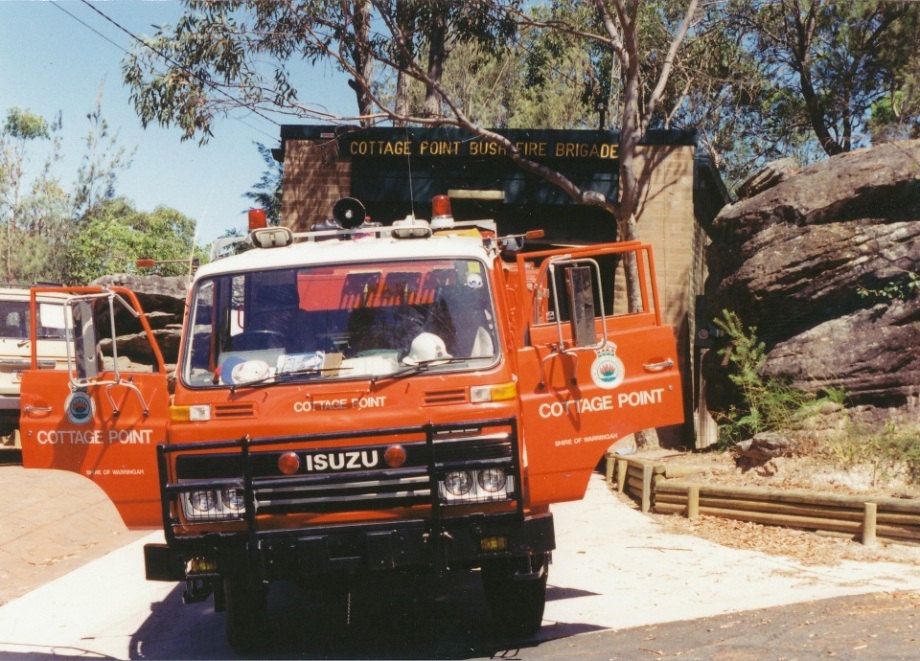
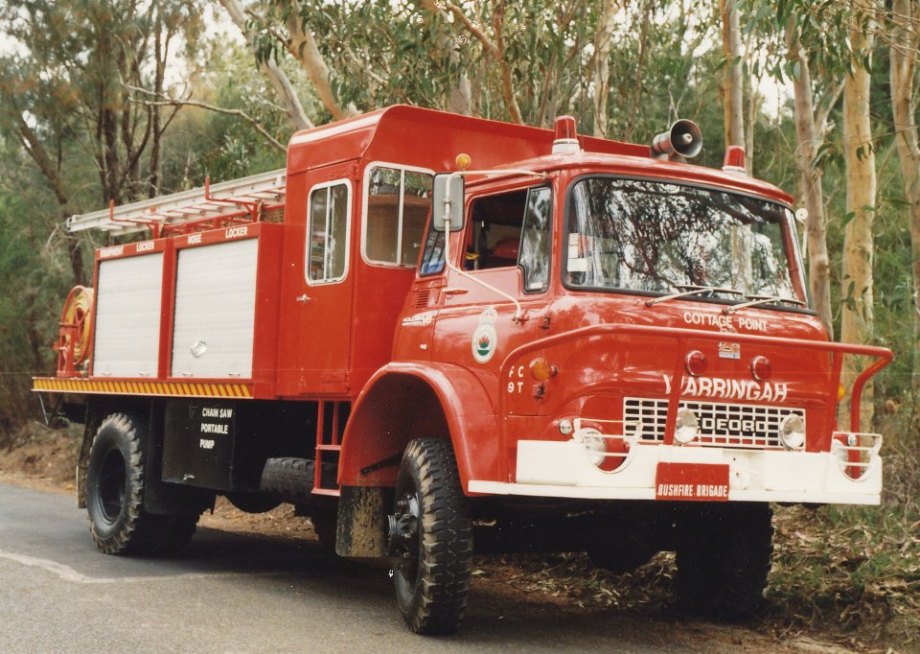
Even back in the 1990’s we’d take it from Cottage Point up to Terrey Hills Control Centre to give it a run, wash it down and fill the tanks with water and then take her down to Hutton’s Garage down Booralie road to fill it with fuel and it would take $100.00 worth. There were times when Murray was asked if he really needed to fill the truck that week, it was a lot of money.
We’ve had a number of new trucks over the years. The one we have at present is just over a year old and the absolute latest, the first of the new automatic for wheel drive tankers.
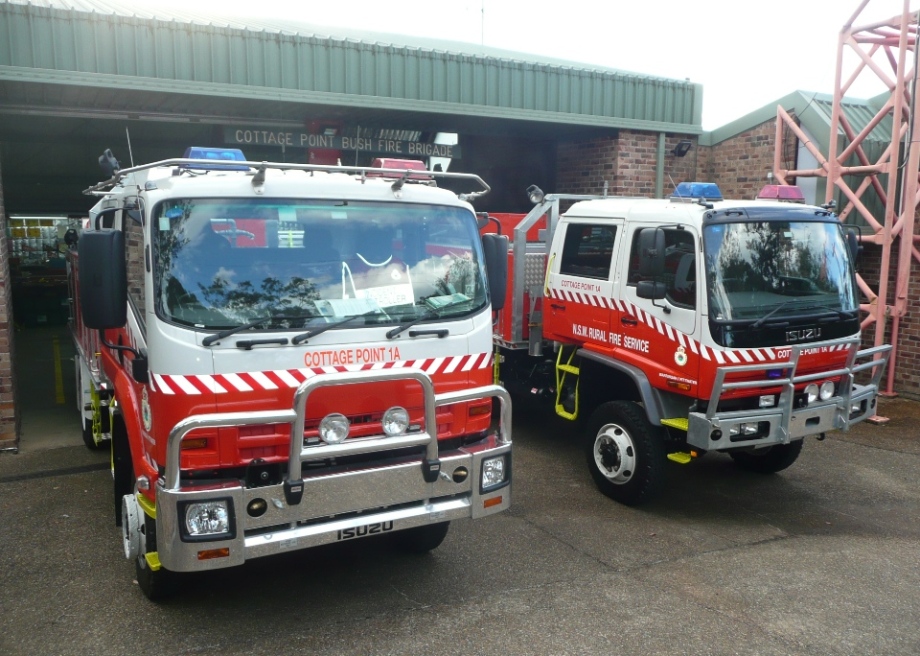
What does that mean?
This is an IZUZU for wheel drive with an automatic transmission, just like a car. For those who are not fulltime regular heavy vehicle drivers this makes the whole ball game a hell of a lot easier.
Does whomever drives the tanker have a special licence?
They must have a Medium Rigid for a Tanker licence. To get your licence through a Driving School these days can cost you a couple of thousand so the Brigade assist people there, which helps the Rural Fire Brigades serve the community. Once people do get their licence they are then put through an Accredited Rural Fire Driver Course. This helps people have better skills for handling the vehicle on the road and most particularly, off the road.
So there are a lot of Training opportunities, which are all nationally accredited skills.
Who would you like to see wanting to join in at Cottage Point?
This would ideally suit younger members of our community, they will have access to these courses, and expanding their own skills base as a result, something that can be applied anywhere, and they will get to spend time in a beautiful environment – if you like the bush and the water, this is the place to be. They will need to have wheels to get here of course, but if mum or dad can get them here if they’re 17, and they’re keen, we’d be pleased to have them on board.
The Rural Fire Service is a great place to not only give something to your community but build yourself up as well. When a younger adult has got something they can stick their head into, something which is teaching them new skills, building confidence, helping them be part of a team, they’re doing something which will give them back a tenfold sense of achievement by being involved in something like this.
The friends they make will be mates for life. The skills they acquire from basics through to the more advanced courses on offer remind you life is learning.
Does Cottage Point have a mascot or a motto?
We have a koala that’s been ‘stationed’ here for years.
I said, ‘oh no, we can’t do any hazard reductions now’. (Laughs)
We got National Parks and Wildlife down straight away – they were as stoked as we were. You see the signs ‘watch out for koalas’ but that’s the first time I’d seen one, a little bugger. Wonderful.
Cottage Point Rural Fire Brigade
Jon Russell
Captain
Cottage Point Brigade
Warringah / Pittwater District
NSW RURAL FIRE SERVICE
Station Ph: 9456.7444
Mobile: 0407-242- 570
Brigade Training Details - Training is held 3rd Monday of every Month.
Brigade Meeting Details - General Meetings are held 1st Monday of every Month.
Extras:
Warringah Pittwater RFS
The Warringah Pittwater District has approximately 1,200 volunteers that provide service to the community through effective Operations, Risk Management, Community Safety, Education and Learning and Development activities, through various roles of Firefighting, Communications, Catering, Logistics, Aviation, Fire Investigation, Cadets and many more.
All of the Brigades and members within the Warringah Pittwater District are committed to their role in ensuring the ongoing protection of life and property from fire and other emergencies and to assist other Emergency Services when required.
The members of our 17 Brigades live within the community and give freely of their time to provide a service to the people of the Warringah and Pittwater area as well as to other communities within New South Wales and other States as requested. For more information on each brigade click here The Warringah Pittwater Rural Fire Service has continued to be a leader in bushfire suppression, hazard management and training which reflects our ongoing commitment to the community.
Join the NSW RFS
Becoming a volunteer with the NSW RFS is easy.
To make an application, contact your local rural fire brigade.
If you're not sure where your closest brigade is located, or you would like more information, contact us using the form below.
What is the application process?
Once you've completed an application form you will be invited to attend an interview with the brigade you are seeking to join. The interview will cover the types of things you can expect as a volunteer of the NSW RFS, what your voluntary role will involve and what the NSW RFS expects from its members. During the interview, you will need to bring along 100 points of identification.
It is important for the NSW RFS to make an assessment about each applicant's suitability for membership because our volunteers hold a position of trust within the community. Background checks are an important step in this process, and a criminal history check will be conducted after your application form is completed and your interview has been conducted.
If your application for membership is successful, you will be accepted as a probationary member of the brigade for a minimum period of six months. During this time you can undertake some activities and training, and at the end of the probationary period your brigade will vote on whether to accept you as an ordinary member.
Want to join the team? Enquire today using the form below.
Volunteer training
Local NSW RFS district offices deliver most of the training provided for volunteers in the NSW RFS. A District Officer is appointed in each area to oversee the Learning and Development (L and D) function. They will usually coordinate a local Training Team, made up of local volunteer trainers and assessors. There are about 2000 volunteer trainers and 1000 volunteer assessors in the NSW RFS.
Volunteer development
Some volunteers of long standing may wish to become more involved in the leadership and management of brigades in their area, take on roles within Incident Management Teams (IMTs) or aspire to become full time employees of the Service. The Volunteer Development Programs are designed to help satisfy such needs. In some cases the programs are unique to them, but others are shared programs with other volunteers run at a local or regional level, or shared with staff at a state level. It provides a link between the volunteer and staff training and development systems.
Staff training and development
More than four out of five members of staff in the NSW RFS are current or former volunteers. The volunteer training system provides a foundation for many of the career qualifications needed by staff with Operational, Learning and Development and Community Safety roles. The system is designed to provide relevant competencies and qualifications that, as far as possible, are readily obtainable, enable career progression and variety within the NSW RFS, and are widely recognised in other workplaces should a person choose to leave the NSW RFS. It also provides for short courses to facilitate changes in technology or legislation, and to address any training issues identified in performance reviews.
Youth in the NSW RFS
Membership Opportunities
Children and young people play an important role within the NSW RFS and in local communities. Participation in NSW RFS activities can help children and young people connect with their community and develop a sense of social responsibility.
Many NSW RFS brigades offer junior or cadet membership for young people aged from 12 years, however these opportunities vary from area to area depending on a brigade's capacity to supervise, mentor and develop junior members. This may mean some Rural Fire Brigades limit the number of young people in their brigade. Similarly, a Brigade may also raise their minimum age requirement so their programs are age appropriate.
Secondary Schools Cadet Program
The NSW RFS Secondary Schools Cadet Program provides Year 9 and 10 students with an insight into fire safety and prevention whilst developing practical life skills and a general appreciation of community service and volunteerism.
Young people participate in the 10 week Secondary Schools Cadet Program through their school, as school students (not as members of the NSW RFS). The Secondary Schools Cadet Program can be linked to NSW Personal Development, Health and Physical Education (PDHPE) Years 7-10 Syllabus.
For more information see our Secondary Schools Cadet Program information brochure.
New Fire Trucks For Pittwater’s Rural Fire Service Brigades
On 10th of November 2014 Member for Pittwater Rob Stokes announced five new fire trucks will be provided to Rural Fire Service brigades throughout Pittwater.
The NSW Government’s investment of over $30 million to continue upgrading the State’s Rural Fire Service fleet and brigades in Pittwater included Cottage Point, Scotland Island, Duffys Forest, Coal and Candle and the District Headquarters at Terrey Hills were part of this.
Readers will recall the new truck Ingleside RFB received a few months prior to this in 2014
“These new fire trucks will provide a welcome boost for our local brigades,” Rob Stokes said in 2014.
“With technology constantly improving it’s vital our Rural Fire Service volunteers have access to the latest equipment and resources.
“We’re really fortunate to have so many dedicated volunteers willing to put aside family, work and personal commitments to help keep our community safe.
“These outstanding volunteers do a sensational job during difficult and often chaotic circumstances.
“This investment in new equipment is a key part of ensuring our community continues to maintain the highest levels of bushfire protection,” Rob Stokes said.
Pittwater has ten Rural Fire Service brigades including Ingleside, Great Mackerel Beach, Terrey Hills, Cottage Point, Coasters Retreat, Duffys Forest, Coal and Candle, Scotland Island, West Pittwater, District Headquarters and Tumbledown Dick.
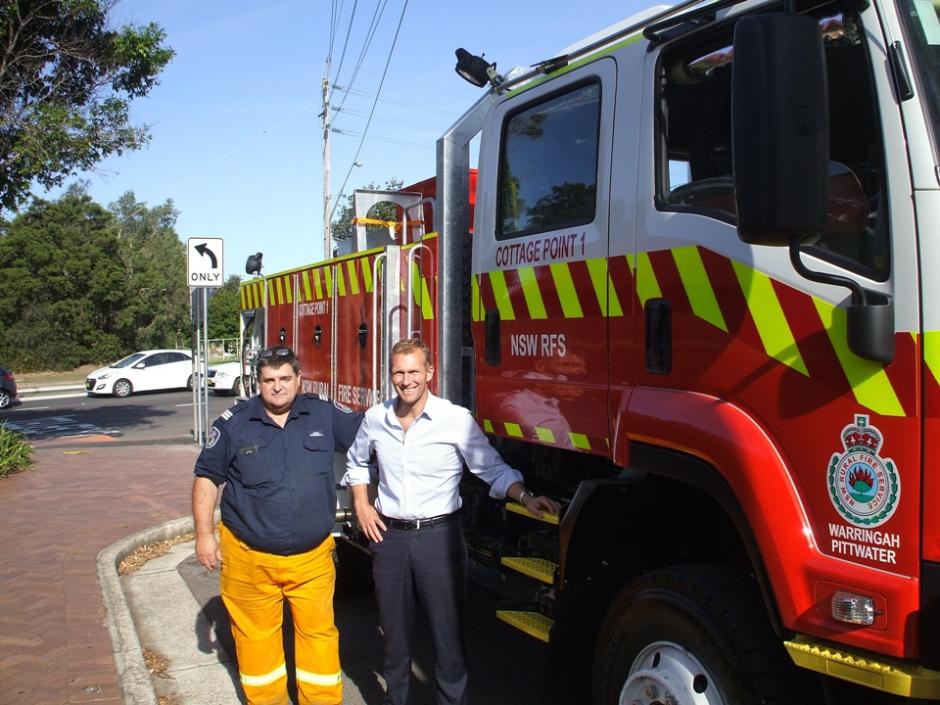
Cottage Point RFB Captain Jon Russell with MP for Pittwater Rob Stokes and the new truck in 2014
Photos Copyright Cottage Point RFS Brigade, 2016.